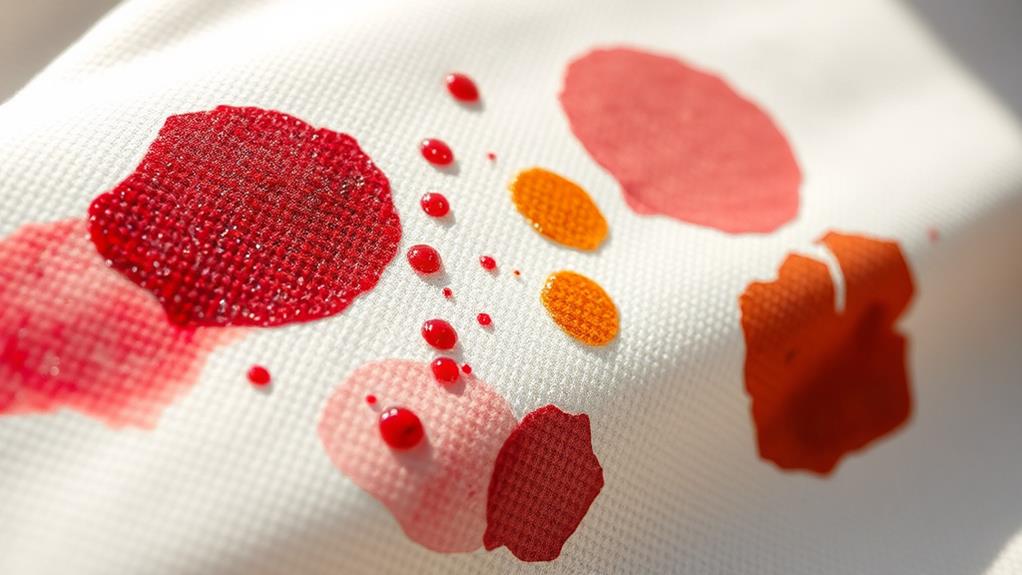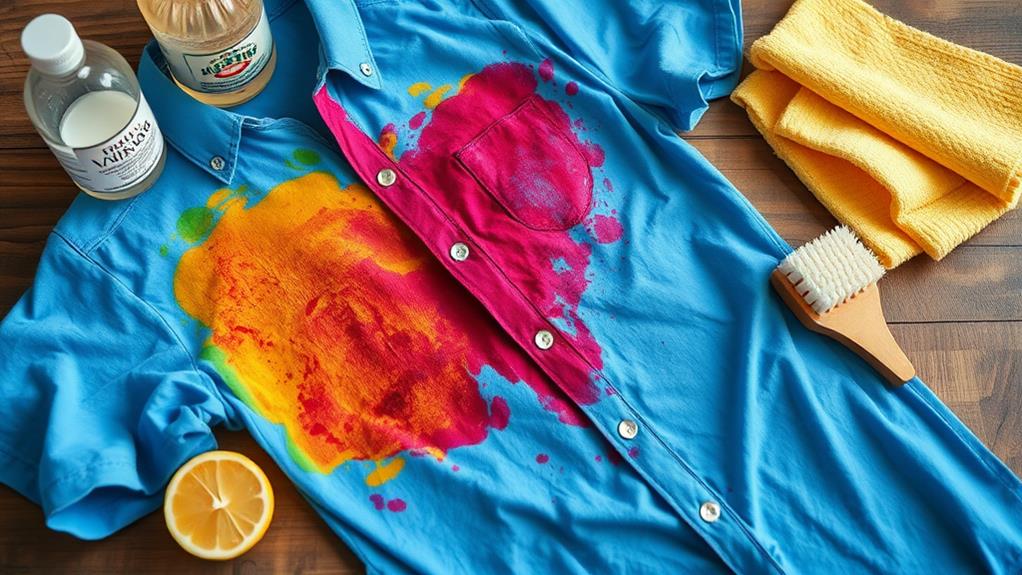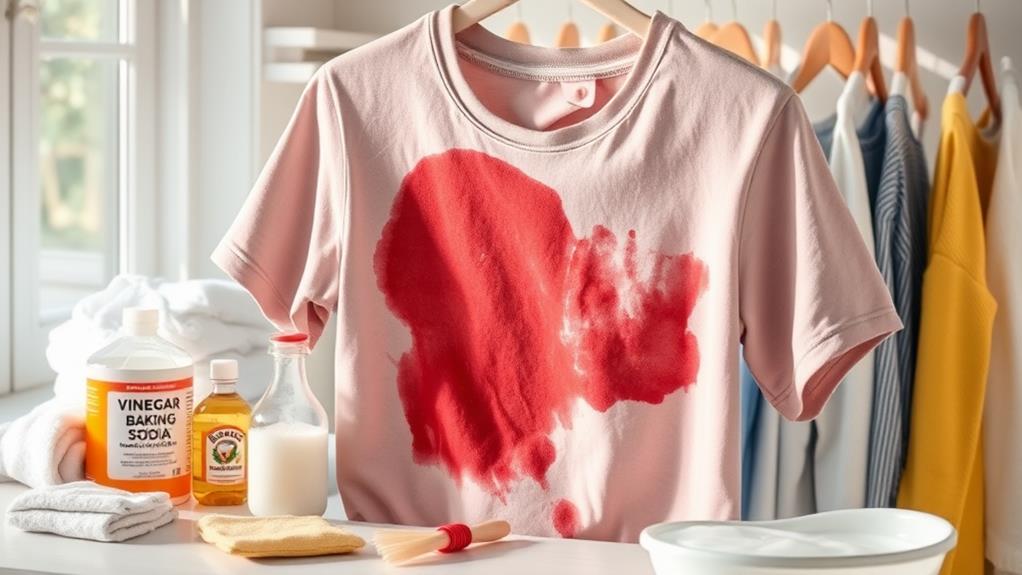Proven Methods to Remove Set-In Stains From Clothes
When you face set-in stains on your clothes, the frustration can be overwhelming, but you don't have to resign yourself to those marks forever. You can employ proven methods that tackle these stubborn blemishes effectively. By understanding the right techniques, like the use of oxygen bleach or white vinegar, you can reclaim your garments. But what about those particularly tough stains that seem impossible to remove? There are specialized approaches that might just surprise you. Let's explore these options and see how they can transform your laundry routine.
Understanding Set-In Stains

Set-in stains can be a frustrating challenge for anyone who does laundry. These pesky marks happen when you don't treat fresh stains right away, letting them bond tightly with your clothing and linens. You might find them from food, drinks, sweat, or even those embarrassing moments involving bodily fluids.
Once these stains settle in, they can be stubborn, especially if they're protein-based stains or involve grease or oil. The longer you wait to remove set-in stains, the harder they become to tackle. Quick action is key! If you spot a stain, don't just shrug it off—grab your stain removal tools and get to work.
Different fabrics react differently, too. Cotton and polyester, for example, can hold onto stains like a dog to its favorite toy. You might need to use specific effective removal techniques to get those stubborn stains out.
If you're still struggling, don't worry! Professional cleaning services can help save the day. They've special treatments for set-in stains that home methods sometimes can't touch.
Effective Use of Bleach
When it comes to tackling set-in stains, using oxygen bleach can be a game changer. This powerful stain-fighting agent, often made with sodium percarbonate, works wonders on stubborn marks.
To start, you'll want to soak the stain in a large container filled with hot water and oxygen bleach. Let it soak for about 5-6 hours. This soaking time really helps enhance stain removal, giving the bleach a chance to do its magic!
While soaking, make sure to check the progress of the stain. If it looks like it needs a little extra help, don't hesitate to reapply some oxygen bleach.
After soaking, you can wash the garment as usual, but be careful—don't toss it in the dryer if any stains remain. Heat can set those pesky stains permanently, and we definitely don't want that!
For the best results, keep a stain removal kit handy, stocked with oxygen bleach. This way, you'll be ready for any set-in stains that come your way.
The Power of White Vinegar

White vinegar is a powerful ally in the battle against stubborn stains. This amazing liquid can help you remove set-in grease stains and other tough marks from your clothes. To start, just saturate the stained area with white vinegar and let it sit for a few minutes. This simple cleaning method works well to break down those pesky stains.
For tougher stains, you can mix white vinegar with baking soda to make a paste. Scrub this paste into the stain, and you'll see how effective it can be.
If you really want to tackle set-in stains, soak the stained item overnight in a mixture of vinegar and detergent. You'll be amazed at the results when you wash it out the next day!
Just remember to always rinse and wash the fabric after using vinegar.
And here's a tip: don't dry the item until you're sure the stain is completely gone. You wouldn't want to bake in that stubborn mark!
With a little patience and some white vinegar, you can say goodbye to those annoying stains and hello to fresh, clean clothes!
Targeting Specific Stains
Stains come in all shapes and sizes, each requiring a unique approach for effective removal.
Let's explore some specific types of stains and how to tackle them. If you're dealing with blood stains, don't panic! For fresh stains, apply hydrogen peroxide or a paste made from cornstarch and water. If it's dried on, soak it in warm water with enzyme cleaners before you wash it.
Ink stains can be tricky, but you can conquer them by spraying hairspray directly on the stain. Follow that up with a rag soaked in vinegar to blot it away.
For those pesky sweat stains, mix up some crushed aspirin with water, soak the shirt for 2-3 hours, and then wash it normally.
Grease stains? No problem! Just put some dish soap in a Ziplock bag with the stained item, soak, and shake it around.
Finally, if red wine spills on your favorite shirt, quickly blot it, then sprinkle salt on the stain and pour boiling water over it. Don't forget to wash the item afterward!
With these techniques, you'll be a stain-fighting hero in no time!
General Stain Removal Tips

Getting stains out of clothes can feel overwhelming, but with the right approach, you can tackle them effectively. First, always check the care label before diving into your laundry. It'll tell you how to treat different fabrics without turning them into a fashion disaster!
When you spot a stain, act fast. The sooner you treat it, the better your chances are for success. Use cold or lukewarm water for rinsing, as hot water can make old stains set in even deeper. Nobody wants that!
If you're using soap or vinegar, dab it on the stain gently, then rinse with cold water. This method works wonders for many types of stains.
Be sure to check that the stain is completely gone before tossing the item in the dryer. Heat from the dryer can lock in any remaining stains, making them permanent.
And remember, for dry-clean only clothes, it's best to blot the stain and get professional help instead of trying to fix it yourself. You want your clothes looking fresh, not like a science project gone wrong!
Just follow these tips, and you'll be a stain-fighting pro in no time!
Specialized Techniques for Stains
When faced with stubborn stains, having specialized techniques in your cleaning arsenal can make all the difference.
For blood stains, if you act fast, rinse fresh ones with cold water. But for set-in stains, soak the fabric in warm water mixed with enzyme-based products or hydrogen peroxide.
Ink stains? No problem! Just apply hairspray to the stain, then blot it with a vinegar-soaked rag to lift it away.
Sweat stains can be tricky, but a paste of crushed aspirin and water works wonders. Apply it to the stain, let it soak for 2-3 hours, and then wash as usual.
Now, grease stains are no match for liquid dish soap. Apply it directly to the stain, seal it in a Ziplock bag, let it soak, and wash in hot water.
Lastly, for those really stubborn set stains, mix white vinegar with baking soda to create a paste. This method enhances your scrubbing power, especially on grass and food stains.
With these specialized techniques, you'll be well-equipped to tackle any stain life throws your way!
Professional Cleaning Options

If you're struggling with set-in stains that just won't budge, professional cleaning options can be a game changer.
Using professional cleaning services, like Great American Laundry, gives you access to laundry experts who know exactly how to tackle tough stains. They utilize specialized stain removal techniques and products that you mightn't find at home, ensuring those pesky stains are treated effectively.
Plus, many of these services offer convenient options like wash and fold, which is perfect for busy schedules. You can drop off your clothes and let the experts handle everything—talk about a time-saver!
When you consult with laundry professionals, you get personalized advice tailored to your specific stains and fabric care needs. They'll help you choose the best cleaning options for your delicate items, ensuring expert handling to prevent damage.
Best Practices for Prevention
To keep set-in stains at bay, regularly checking your clothes for spots before washing is essential. If you spot any stains, treat them quickly with your stain removal kit, which should include helpful items like white vinegar. This way, you can prevent them from setting and becoming a bigger headache.
Always follow care labels on your clothing. They give you specific instructions that can help you avoid damage that leads to stubborn stains.
When storing clothes, make sure to keep them in a cool, dry place. This reduces the likelihood of mold and mildew stains, which nobody wants to deal with!
Also, treat potential stain sources—like food and drinks—with caution. Use protective coverings, especially during meals. Trust me, a little extra effort can save you a lot of scrubbing later.











Post Comment